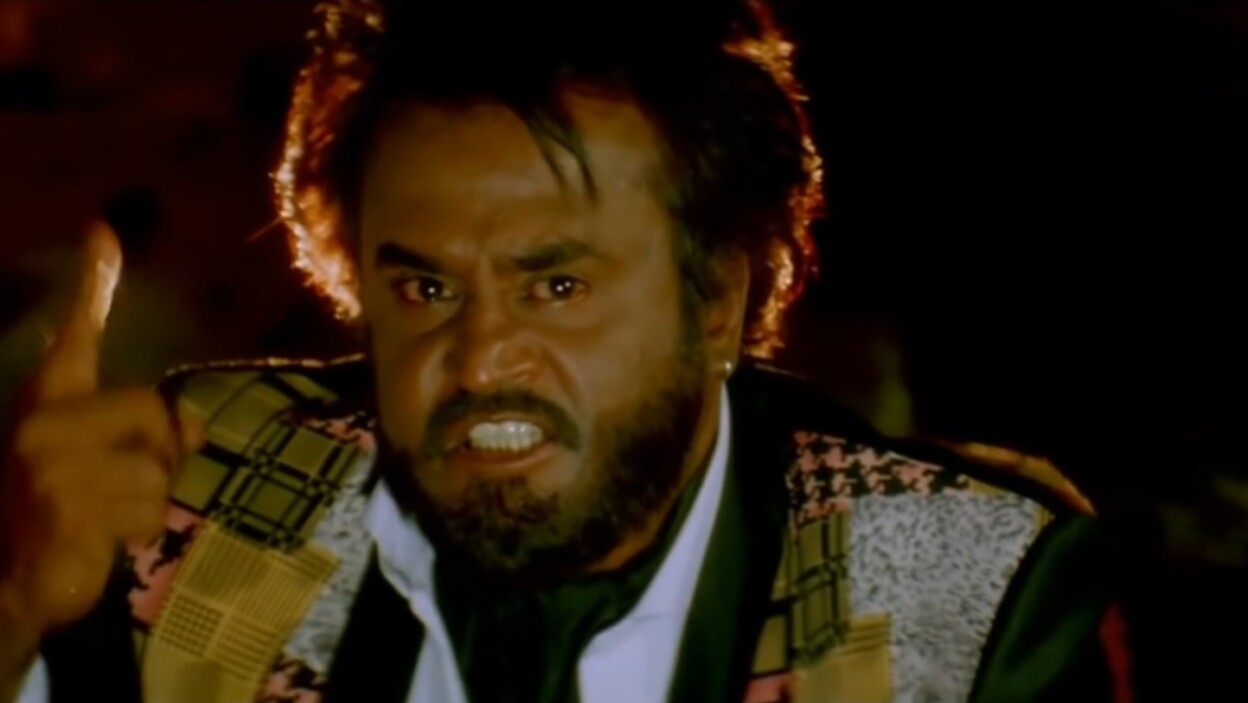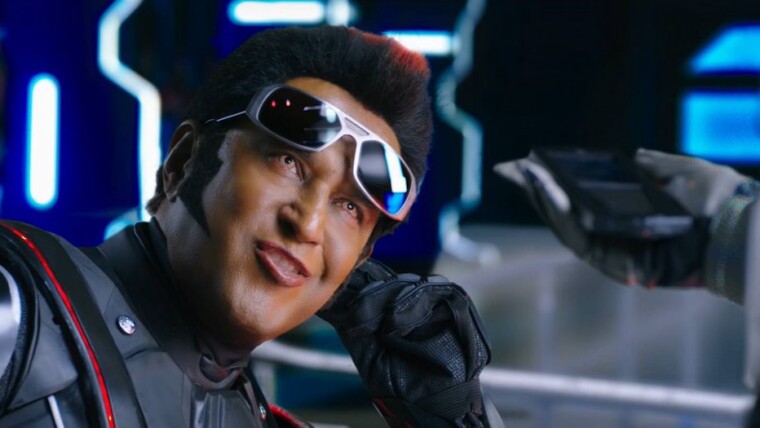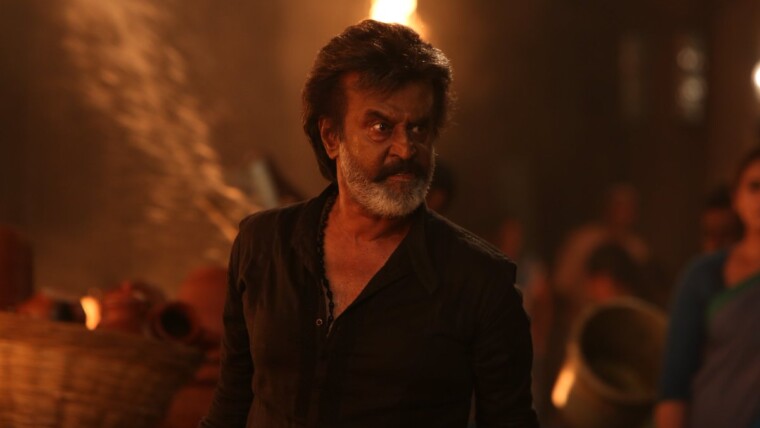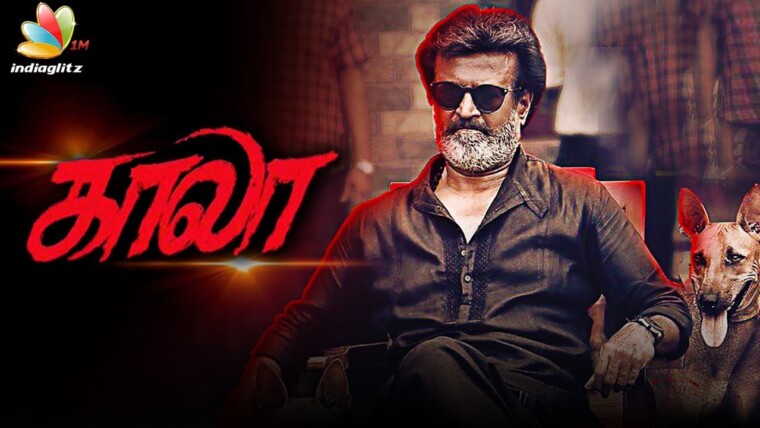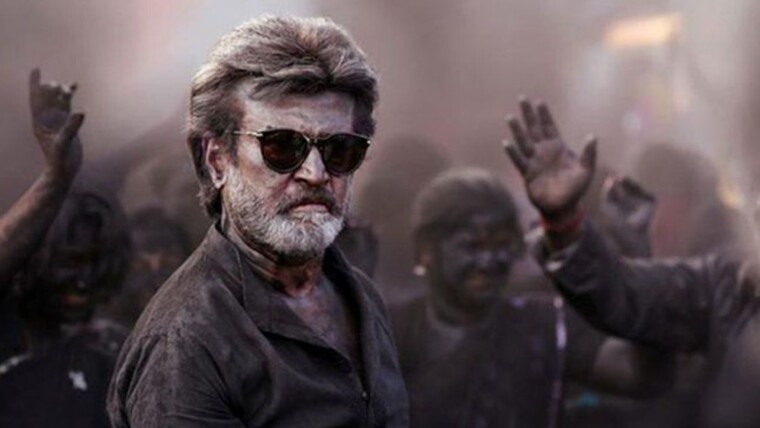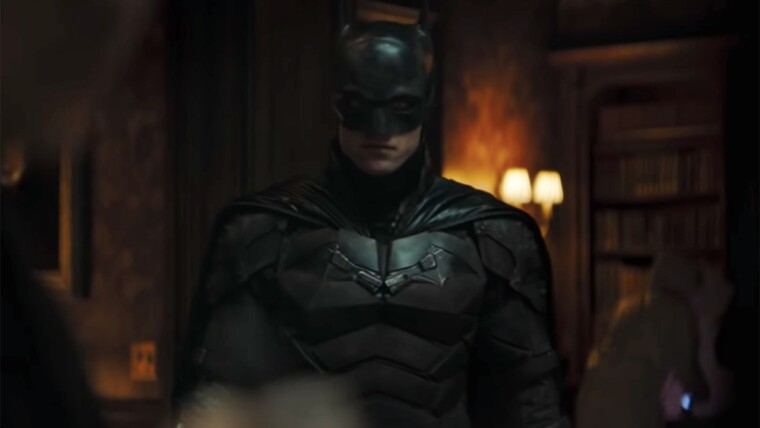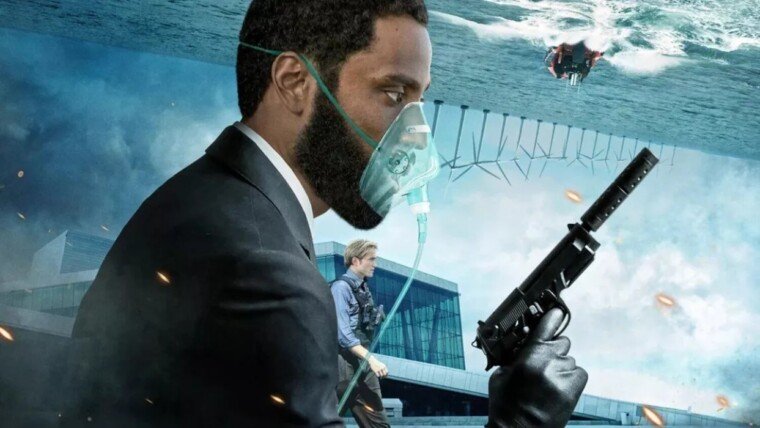You can also click here to read my Kaala review.
Aesthetically speaking, the interval fight scene in Baashha is nothing extraordinary, especially when viewed through today’s lens. The choreography is bland and the over-exaggerated sound effects only serve as a cheese platter. Yet, when the film was re-released in 2017, the response from the crowd when Manickam punches the thug onto the lamp post is just as it was 22 years ago — deafening. Screams by fans so rabid, so fiery, so passionate that it almost drowns out composer Deva’s epic score blaring through the speakers. Just take a look at the video below.
https://youtu.be/K48AhX3LOdc?t=1m6s
While the Mass genre (a genre unique to South Indian cinema) is famous for its boisterous fan reactions, it takes a special kinda scene and a special kinda film led by a special kinda man — Superstar Rajinikanth — to garner a reaction quite like that, especially considering the film’s age. I didn’t catch Baashha in cinemas when it was first released in 1995. I was only 2 years old at the time. But since then, I have watched it more times than I can count on two hands and two feet and buddy, believe me when I say, that’s a tame estimate. Despite that, my adrenaline still kicks into full gear and warm tears start filling up my eyes every time I see Rajini’s character Manickam turn to his brother and roar, “ULLE PO!!” (go inside!).
Notes:
-
Masala: A genre unique to Indian cinema. Larger than life, sweeping stories with a blend of drama, comedy and musical.
-
Mass: A subgenre of masala, unique to South Indian cinema. Equipped with grand hero introductions, stylistic action-sequences, a middle finger to real-world physics (How is Rajnikanth able to singlehandedly beat the living crap out of 52 people? I don’t know, ask John Wick) and packs of fans ready to whistle till their lungs collapse.
The Indian Star Wars
Look, before your face turns into Jackie Chan’s in the WTF memes, hear me out. I may be crazy, but not crazy enough to argue that Baashha has a similar storyline to that of Star Wars. I also recognize that one’s a mass-masala and the other is a Sci-Fi-fantasy. Instead what I’m talking about is Baashha‘s cultural relevance and how it changed South Indian cinema forever after. But to even have this conversation, we must include both Steven Speilberg’s Jaws and Suresh Krissna’s first collaboration with Rajinikanth, Annamalai in the conversation.

It is widely accepted that Jaws popularized, if not birthed the concept of a Hollywood ‘blockbuster’ in 1975 — people would line up around the block to purchase tickets, something unprecedented in Hollywood prior to that. A couple of years later, George Lucas’ Star Wars: A New Hope gave the term a whole new meaning. The film set new box office records, grossing a whopping $US 786.5 million at the global box office, redefining ‘event films’ in the process. A New Hope changed the landscape of Hollywood for better or for worse.
About two decades later, South Indian cinema would see something similar occur. South Indian cinema has always had big stars that drew big crowds. The early days (40s – 70s) saw M. G. Ramachandran (MGR) dominate the South Indian box office. Many of the films he starred in ran in Indian cinemas for more than 150 days; some like Ullagam Sutrum Valiban and Urimai Kural even dashed past the 200 days mark. The 80s, on the other hand, witnessed the rise of Rajinikanth, who became a big action star after making a series of hits like Murattu Kaalai and Paayum Puli. Murattu Kaalai, in particular, was reportedly the highest grossing movie in South Indian cinema at the time, raking in over Rs 4 Cr (USD$ 583k). But something happened in 1992. Something that made the whole industry stop in their tracks and lose their collective shit.

An accidental pairing of Rajinikanth and director Suresh Krissna (Suresh Krissna was pushed to direct the film at the eleventh hour after the original director decided to drop out at the tenth hour and 59th minute. There wasn’t even a fully fleshed out script a couple of days before production commenced) created a movie so huge it shot Superstar Rajinikanth to the stratosphere. Much like Star Wars and the Marvel Cinematic Universe (over the past decade), Rajinikanth became a brand. He became S.U.P.E.R S.T.A.R R.A.J.N.I, packaged with his own title card. Annamalai grossed Rs 17 Cr (USD$ 2.5 mil). If that was special, then what happened three years later was something otherworldly.
In recent years, Suresh Krissna has mentioned that in 1993, a friend of his who was working on the Hindi film Hum gave him an idea for a MASS scene (which will be discussed later). Suresh Krissna loved it so much that he immediately contacted Rajnikanth, eager to flesh out the idea and turn it into a feature film. But Rajinikanth, in what retrospectively turned out to be a genius move, told Suresh Krissna to put that idea on hold. “Our combo just shook the landscape of Indian cinema a couple of years ago. Let’s make a throwaway comedy next, simply to cleanse the audience’s palette and remove any and all expectations.” Insert Veera.

It wasn’t until 1995 that Baashha was born. And just like A New Hope, Baashha would go on to shatter box office records in a manner that at the time didn’t seem plausible or even logical. Baashha grossed Rs 35 Cr (US$ 5.1 mil) — in today’s currency that’s more than Rs 184 Cr (US$ 27 mil). It would also go on to be the first Indian movie to be a huge financial success in Malaysia and Singapore, raking in US$ 650k and SG$ 400k respectively.
But more than breaking the bank, Baashha redefined the term ‘mass’ and reshaped the landscape of South Indian cinema. And just like Star Wars, for better or for worse. For better because it pushed South Indian cinema’s market beyond its borders. For worse, because almost every South Indian actor since then has strived to be the next big mass hero, following the Baashha template. Only a handful have succeeded (Vijay and Ajith), though not quite at the level of Rajinikanth.
A lack of structure?

Had Baashha been released for the first time today during the height of film criticism, I can imagine many reviewers pointing out the film’s feeble skeleton. At first glance, Suresh Krissna’s screenplay doesn’t seem to obey the basic laws of a three-act structure. Here, the villain who’s set up in the first act does not in any shape or form influence the second and third act of the film. In fact, the entire second act of the film is a flashback followed by a swift resolution in the third.
Interestingly enough, while most action films (Die Hard, John Wick, Mersal, The Raid, Sivaji) is designed based on the question “how will our hero defeat the villain?” this Suresh Krissna film revolves around three words: Who is Baashha? And with that in mind, the movie is perfectly structured. The first act sets up the character of Manickam while teasing his mysterious past. The inciting incident is the interval fight scene in which we get to see the power of Baashha for the first time. The second act sees Manickam confront his past via flashback. And the third act closes off the story when the police officer says, “Don’t do it. You’re not the old Baashha. You’re auto-driver Manickam.” Everything ties back to the idea of “who is Baashha?”
The art of the ‘build-up’
It’s funny how this film, which is still widely considered to be the granddaddy of the mass genre, has literally no explicit mass sequences in the first hour of the film. The key is restraint and here, Suresh Krissna exercises a ridiculous amount. The entire first hour of Baashha is just a build-up that slowly escalates. But Suresh Krissna also knows that restraint alone isn’t enough. Every single scene in the first half is interesting and almost every one of them, important.

The film opens with Rajinikanth’s character Manickam, an auto-driver singing and dancing at his auto-stand. Then we’re introduced to his stepmother and three half-siblings. We later learn of a promise he made his late father (Vijayakumar) in his dying breath — “Ensure your sister becomes a doctor. Your brother, a police officer. And marry your other sister off to a good family.” A dead Vijayakumar is Suresh Krissna’s first poke at the audience. After all, you don’t include an actor of his calibre just to have his face in a photo frame.
When a neighbourhood gangster cat-calls Manickam’s sister as their family is walking down the street, he stops his police officer younger brother from confronting the thug: “When you throw a stone in mud, the mud will splash back onto you.” When a fight breaks on the street, Manickam immediately reverses his auto and heads in the opposite direction. Manickam is a kind soul, innocent and afraid of violence.

But Suresh Krissna doesn’t keep Manickam’s past hidden from us completely. Because the point isn’t for us to wonder if Manickam has a badass past — of course, he has — but rather for us to sit in anticipation, for our eagerness and restlessness to brew. And so we get glimpses, in scenes that will get your heart racing. First up, when Manickam walks into a police station, the senior inspector stands up, with a look of disbelief plastered on his face. The music changes — we get a variation of The Terminator theme.
Or what about the scene where a bunch of thugs tear his auto to shreds. There’s a close up of Manickam’s eyes ala Clint Eastwood in the old westerns, followed by a close up of his fist clenched. We then cut to a flashback of him promising his father who’s about to die, “No more Baashha. No more Bombay,” and we see his eyes shift from fierce to tranquil, fist loosened. But also notice how other characters react to the situation that’s unfolding. We see his best friend/fellow auto-driver shaking his head and stopping the neighbourhood mechanic and petty shop worker from doing anything. We see his stepmom watching from a distance. These characters have a look on their faces that suggest they know who Manickam really is (or perhaps they were a part of who he really is too).
And then we have the medical college scene. A scene that’s just as iconic as the film itself. The seed that essentially grew into the movie. I mentioned that back in 93/94 Suresh Krissna’s friend had given him an idea that was initially pitched for the movie Hum. But for one reason or another, Hum director Mukul S. Anand figured the scene wouldn’t fit the tone of the film. The idea? Amitabh Bachchan would be alone with a police inspector in the inspector’s office. He would then say “My name is Shekhar. But I have another name.” After which we will cut to his brother looking on from the outside, wondering what’s being said inside. It is this unused idea that Suresh Krissna built Baashha around.

In Baashha, Manickam approaches the college dean who tells Manickam’s sister Geetha that she’ll only be given a seat in the college in exchange for sexual favours. Manickam tells his sister to wait outside. He puts his hands on the table, looks down at the dean and says, “My name is Manickam. But I have another name.” We then cut to Geetha’s perspective, as she wonders what on earth her innocent auto-driver brother is telling the man (the monologue is muted), causing him to shiver. We’re left wondering too. It’s filmmaking at its best!
Suresh Krissna and Rajinikanth (who provided a lot of story ideas) also understood that teasing alone isn’t enough. On the contrary, there needs to be an incident so dour that when the audience finally explodes later in the film, it isn’t just joyous but also passionate — compare the way football fans scream when they’re team wins 1-0 in the world cup finals, to the manner in which they explode winning 2-1 in the 90th minute, having conceded the first goal.
We have seen heroes get their ass handed to them long before Baashha, and we have continued to see it long after. But though many of those scenes make you feel uneasy, none are quite the gut punch as the scene in Baashha when Manickam is tied to a pole and beaten to a pulp. But to understand why that scene is so impactful and important, one must be familiar with the pseudo-religion that is Superstar Rajinikanth.
Rajinikanth’s star power goes past fans lining up around the block hours before the ticket counter opens. It stretches beyond people screaming and cheering in the cinema like it’s a friggin live football match. It doesn’t stop at him being the second highest paid Asian actor — more than Donnie Yen, more than Chow Yun Fat — despite only starring in one Hollywood movie way back in 1988. No, Rajinikanth is, as they say, vere level. In India, people shower 5-storeys-tall Rajinikanth posters with milk, like they would Lord Murugan during Thaipusam.

And so, to see him tied to a pole and beaten to a pulp in an emotionally exhausting sequence that seemingly goes on forever is not just saddening. It is shocking. To Rajinikanth fans, it is akin to watching Jesus Christ tortured in The Passion of the Christ. So much so, that the producers of the movie put their foot down and told Suresh Krissna that they will not allow the scene to be shot and included in the movie: “Are you mad?! Do you want the audience to riot and burn the cinema down?” It was Rajinikanth himself who convinced the producers to allow the scene to be included by offering to put his own money on the line.
My dad often speaks of the atmosphere in the cinema during this scene back in 1995. It was something he had never experienced in his life before or after. Absolute pin drop silence, as people’s excitement slowly turned to discomfort. The air was completely sucked out of the thousand seater theatre and tears rolled down the cheeks of little kids, teenagers, adults, even grandparents. Everybody had one thing on their minds, “Why isn’t this man hitting back?”
The explosion!
For the first hour of the film, Suresh Krissna teased us. And then he crushed our hearts. And that is why at the one hour and eight minutes mark, the film makes us explode, regardless if you’re watching it on the big screen in a packed theatre or on your tiny laptop. Despite the cheesy ‘doosh doosh’ sound effects and poorly choreographed fight sequences, your heart starts racing like you’re being chased by a pack of Rottweilers because of the effectiveness of the storytelling and the capacity of the star who’s leading it. When the local gangster hits and shoves Manickam’s sister, and you see his hand appear in-frame to catch her right before she hits the ground, you know shit is about to get real.

I’ve been a movie buff for as long as I can remember. I’ve seen a lot; from a live action Optimus Prime transforming for the very first time to The Avengers assembling to the Airport sequence in Captain America: Civil War to Rajinikanth pulling down a swing with his shawl and sitting across Nilambari in Padayappa to the tracking shot corridor fight scene in Oldboy. And while all of those moments are fucking spectacular, none offer the same elation as Manickam (or should I say Baashha) punching the minion thug onto the lamp post followed by the sheer look of disbelief on the faces of his sister, brother and thug leader (Anandaraj) accompanied by the random sound of a train chugging away (it bloody hell works I tell ya!).
After the interval fight sequence, we get the much-anticipated flashback, which opens with a bang. If the first half saw auto driver Manickam sing and dance with a smile on his face, here we have a fully bearded Baashha donning a two-piece suit, solid leather shoes that echo when he struts and a hard-boiled look. The thunderous soundtrack that accompanies Baashha and his gang striding out of their mansion doesn’t have a happy bounce to it; rather, it’s majestic. THIS is the Baashha we’ve been waiting for. Our Baashha!

The story beats in the second half isn’t anything revolutionary. It’s a simple cat and mouse story between Baashha and rival gang leader Anthony (Raghuvaran). What keeps us invested is the sprawling epicness of the storytelling and the performances by our two co-leads. It makes no sense to me when people say Rajinikanth has no range. Here, Rajinikanth turns 180 degrees and brings to life a completely different character from the first half. It isn’t just how he looks and what he wears. It’s his energy. It’s the emotions he channels through his eyes — in the first half, it’s gentle and compassionate, with a tinge of anger simmering underneath; in the second, it’s hellfire and brimstone with compassion broiling beneath. It’s also the weight of his voice. The way he enunciates his words. It’s how he walks. Everything. The tone of the film is different too, and this includes the song Manickam/Baashha dances to. Ra Ra Ramaiya isn’t merry like Na Autokaran; it’s grander in tune and philosophical in lyrics.

They say a hero is only as good as his villain and boy there would be no Baashha without Raghuvaran’s magnetic performance as Mark Anthony. You can’t keep your eyes off him. If Baashha is Robin Hood meets Vito Corleone then Mark Anthony is the worst of Michael Corleone. Rape, murder, threatening the impoverished, he does it all. And Raghuvaran is just dripping with charisma. Despite following an almost paint by numbers ‘rise and fall’ formula, the back and forth between Rajinikanth and Raghuvran is thoroughly entertaining. That Baashha’s father played by Vijayakumar works for Anthony only adds to the intrigue.

Is Baashha objectively perfect? Not quite. The aforementioned averagely choreographed fight sequences and three invasive song sequences — Azhagu Azhagu, Style Style Daan and Thanga Magan — prevent it from being so. But a great movie isn’t necessarily one that is objectively perfect. A great movie is one that manages to move you to such a degree that its flaws become invisible and inconsequential. And Baashha moved me. It made me cry, it made me scream, it made me jump out of my seat and it made me fist pump the air. Heck, it still continues to do so to this day. But it didn’t just move me. It moved my dad and his generation. In fact, it is the kind timeless piece of film that gets passed down from one generation to another. My dad introduced it to me and then we introduced it to my younger sister who was born on this side of the millennium. Recently, I introduced it to a couple of friends whose lexicon of Indian cinema consists of Mersal and Three Idiots. From its hero introductions to its one-liner (Naan oruthadava sonna, nooru thadava sonna maadiri!) this movie changed the landscape of South Indian cinema. For those reasons, Baashha is great. Without it, there would be no Ilayathalapathy Vijay and Thala Ajith. I shudder to think of a world without Baashha.
Hey you! Yes you, hot stuff. Like my article? Leave a comment below and let me know what you think. Also, don’t forget to share it with your buds. And if you’d like to talk movies you can hit me up on Twitter or Instagram here: @dashtalksmovies
https://www.youtube.com/watch?v=JMP2HYdgaqk

